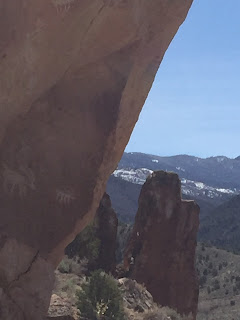 |
| Way smoother than it looks. |
My wing girl read the weather runes just perfectly, which meant our twenty mile ride through Snow Canyon was just superb. I'm pretty sure I could visit this canyon every day. Like I said a day or so ago, in any other state Snow Canyon would have National Park designation. We rode from a small park just North of St. George. The Snow Canyon bike trail took us into the park where we gladly paid our $4.00 fee for the day. We rode the paved trail, uphill, until it ran out. From there we hit the main road, which is brand new pavement as smooth as the inside of a rifle bore. I let gravity play with us until my eyes started to water, trusting the smoothness of the road, the reliability of my equipment, the confidence of my stoker, and we swooshed down, losing quickly the elevation we'd worked so hard for. Judy suggested we ride up and do it again, and we may have if the ominous nature of the gray clouds wasn't lurking behind the mountains. By the time we got back to Frac, the wind had begun to whip the flags, and leaves (There is very little litter here) tumbled like slinkys down the street. Still, after lunch we walked about two miles in order to tour Brigham Young's winter home, which was suggested by Rose Milhem. She was right. As a baptized Catholic and a practicing Presbyterian, I'm fairly far removed from the Mormon faith. I've read a fair amount about their faith, but I have some trouble gaining confidence in much of their doctrine. However, they do family very well, and that's something I appreciate. They also do education well; they work hard; and my gosh, are they beautiful. They're also very kind, and I'd take a Mormon student in my class every day of the week. What teacher wouldn't want a respectful, smart, industrious, well behaved, talented kid to make him/her look good? At Brighten Young's home, a Mormon couple (our age) led the tour. The husband gave the history. The wife led the tour of the home, quite fitting actually. We later met another retired couple from Idaho Falls. Both couples are serving an eighteen month "mission" in St. George as a way of serving the church. Clearly, the spirit of the prophet is upon them, and listening to them answer my questions, it's clear they live in a place of absolute faith. That's easy to respect as well. It reminds me of what I loved about Whitworth College. The professors (and most students) weren't intimidated by my doubt. They took no affront to my questions. They simply presented themselves as they were. I always liked that about Judy's parents and Jack and Chostie as well. The bottom line is, Be good, do good, share willingly, and help everyone you can. I think I can live with that doctrine. We'll be moving on tomorrow even though a cold weather front is about to move along the Wasatch range. Like Judy said, "We can't stay here forever." So, we'll soldier on, realizing as we try to do every day: Life is good, especially today.

There are several round abouts in St. George. Each has sculpture as its centerpiece.
One of the old time Mormon settlers wrote, "If I owned land in Hell and some in St. George, I'd sell the land in St. George." Time has changed a little. This is one in a string of gated communities that house fabulous homes, verdant golf courses, and a large dose of privilege.
There is a small, very popular campground in Snow Canyon. This is the view from site 16B.
We're catching the desert at a time when it's greening up. This photo does little justice to the scene. Make your way down here; it's worth it.
Brigham Young believed in his people being industrious and creative. He always had work done by locals. This fireplace, just one of the amazing wooden pieces, is made out of pine, but it's painted in such a way as to imitate marble. Stunning.
In another show of ingenuity, this stove has a reservoir built in so that hot water was always at the ready (As long as the fire was stoked).
Nothing much in the way of crops grew in St. George, but cotton thrived and provided a good living until after the civil war when the new railroad system brought cheap, Southern cotton West.
You would have found what they call a "Mormon Bed" in nearly every home. It served as both couch and bed. Some even folded out to form a double bed.
The St. George Temple, which is the foundational anchor of the Mormon Saints, built from 1871-76.
This scrumptious pizza pie served as dinner, and will be lunch on the road tomorrow.
I plan to build an outdoor pizza oven in our backyard this summer. It could look something like this.























































